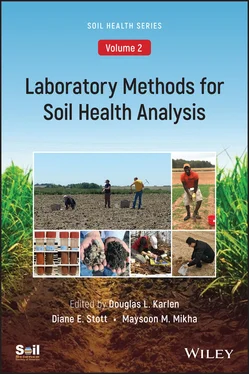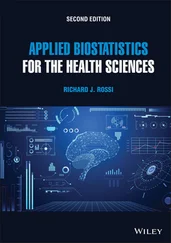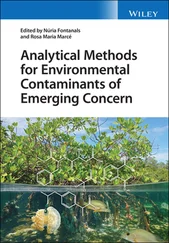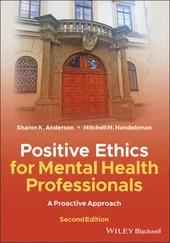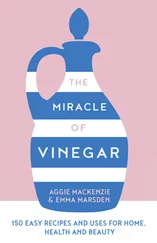Laboratory Methods for Soil Health Analysis, Volume 2
Здесь есть возможность читать онлайн «Laboratory Methods for Soil Health Analysis, Volume 2» — ознакомительный отрывок электронной книги совершенно бесплатно, а после прочтения отрывка купить полную версию. В некоторых случаях можно слушать аудио, скачать через торрент в формате fb2 и присутствует краткое содержание. Жанр: unrecognised, на английском языке. Описание произведения, (предисловие) а так же отзывы посетителей доступны на портале библиотеки ЛибКат.
- Название:Laboratory Methods for Soil Health Analysis, Volume 2
- Автор:
- Жанр:
- Год:неизвестен
- ISBN:нет данных
- Рейтинг книги:3 / 5. Голосов: 1
-
Избранное:Добавить в избранное
- Отзывы:
-
Ваша оценка:
- 60
- 1
- 2
- 3
- 4
- 5
Laboratory Methods for Soil Health Analysis, Volume 2: краткое содержание, описание и аннотация
Предлагаем к чтению аннотацию, описание, краткое содержание или предисловие (зависит от того, что написал сам автор книги «Laboratory Methods for Soil Health Analysis, Volume 2»). Если вы не нашли необходимую информацию о книге — напишите в комментариях, мы постараемся отыскать её.
Analyzing, comparing, and understanding soil health data Soil Health, Volume Two: Laboratory Methods for Soil Health Analysis
Laboratory Methods for Soil Health Analysis, Volume 2 — читать онлайн ознакомительный отрывок
Ниже представлен текст книги, разбитый по страницам. Система сохранения места последней прочитанной страницы, позволяет с удобством читать онлайн бесплатно книгу «Laboratory Methods for Soil Health Analysis, Volume 2», без необходимости каждый раз заново искать на чём Вы остановились. Поставьте закладку, и сможете в любой момент перейти на страницу, на которой закончили чтение.
Интервал:
Закладка:
19 Langdale, G.W., Leonard, R.A., and Thomas, A.W. (1985). Conservation practice effects on phosphorus losses from Southern Piedmont watersheds. J. Soil Water Conserv. 40, 157–161.
20 Lindsay, W.L., and Norvell, W.A. (1978). Development of a DTPA soil test for zinc, iron, manganese, and copper. Soil Sci. Soc. Am. J. 42, 421–428. doi:10.2136/sssaj1978.03615995004200030009x
21 Marotz, C., Amir, A., Humphrey, G., Gaffney, J., Gogul, G., and Knight, R. (2017). DNA extraction for streamlined metagenomics of diverse environmental samples. Biotech. 62, 290–293. doi:10.2144/000114559
22 Miller, R.O., Gavlak, R., and Horneck, D. (2013). Saturated paste extract for calcium, magnesium, sodium and SAR. In Soil, plant and water methods for the western region (p. 21‐22). 4th ed. WREP‐125. Washington, D.C.: Wetlands Reserve Enhancement Program.
23 Mikha, M.M., and Rice, C.W. (2004). Tillage and manure effects on soil and aggregate‐associated carbon and nitrogen. Soil Sci. Soc. Am. J. 68, 809–816. doi:10.2136/sssaj2004.8090
24 Moebius‐Clune, B.N., Moebius‐Clune, D.J., Gugino, B.K., Idowu, O.J., Schindelbeck, R.R., Ristow, A.J., van Es, H.M., Thies, J.E., Shayler, H.A., McBride, M.B., Kurtz, K.S.M., Wolfe, D.W., and Abawi, G.S. (2016). Comprehensive Assessment of Soil Health– The Cornell Framework, edition 3.2, Cornell University, Geneva, NY. http://soilhealth.cals.cornell.edu/training‐manual/(Accessed 7 Oct. 2018).
25 Natural Resources Conservation Service (2020). Soil Health. Washington, D.C.: Natural Resources Conservation Service. https://www.nrcs.usda.gov/wps/portal/nrcs/main/soils/health/(Accessed 20 Feb. 2020).
26 Nelson, D.W., and Sommers, L.E. (1996). Total carbon, organic carbon, and organic matter. In D.L. Sparks, (ed.), Methods of soil analysis: Part 3. Chemical methods (p. 961–1010). Madison, WI: SSSA. doi:10.2136/sssabookser5.3.c34
27 Olness, A., and Archer, D.W. (2005). Effect of organic carbon on available water in soil. Soil Sci. 170, 90–101. doi:10.1097/00010694‐200502000‐00002
28 Olsen, S.R., and Sommers, L.E. (1982). Phosphorus. In A.L. Page, et al., editors, Methods of soil analysis: Part 2. Chemical and microbiological properties (p. 403–430). 2nd ed. Madison, WI: ASA and SSSA.
29 Reynolds, W.D., and Elrick, D.E. (1990). Ponded infiltration from a single ring: I. Analysis of steady flow. Soil Sci. Soc. Am. J. 54, 1233–1241. doi:10.2136/sssaj1990.03615995005400050006x
30 Rhoades, J.D. (1996). Salinity: Electrical conductivity and total dissolved solids. In: D.L. Sparks, editor, Methods of soil analysis: Part 3. Chemical methods (p. 417–435). Madison, WI: SSSA. doi:10.2136/sssabookser5.3.c14
31 Schindelbeck, R.R., Moebius‐Clune, B.N., Moebius‐Clune, D.J., Kurtz, K.S., and van Es, H.M. (2016). Cornell university comprehensive assessment of soil health laboratory standard operating procedures. Ithaca, NY: Cornell University. https://cpb‐us‐e1.wpmucdn.com/blogs.cornell.edu/dist/f/5772/files/2015/03/CASH‐Standard‐Operating‐Procedures‐030217final‐u8hmwf.pdf
32 Sherrod, L.A., Dunn, G., Peterson, G.A., and Kolberg, R.L. (2002). Inorganic carbon analysis by modified pressure‐calcimeter method. Soil Sci. Soc. Am. J. 66, 299–305. doi:10.2136/sssaj2002.2990
33 Sikora, F.S., and Moore, K.P. (2014). Soil test methods from the southeastern United States. Southern Cooperative Series Bulletin 419. Washington, D.C.: Wetlands Reserve Enhancement Partnership.
34 Soil Science Society of America. (2020). The North American Proficiency Test Program. Madison, WI: SSSA. https://www.naptprogram.org/(Accessed 20 Feb. 2020).
35 Stott, D.E. (2019). Recommended soil health indicators and associated laboratory procedures. Soil Health Technical Note No. 450‐03. Washington, D.C.: U.S. Department of Agriculture, Natural Resources Conservation Service.
36 Tabatabai, M.A. (1994). Soil enzymes. In: R.W. Weaver, S. Angle, P. Bottomley, D. Bezdicek, S. Smith, A. Tabatabai, A. Wollum, (eds.), Methods of soil analysis: Part 2. Microbiological and biochemical properties (p. 775–833). SSSA, Madison, WI.
37 Thomas, G.W. (1996). Soil pH and soil acidity. In D.L. Sparks, editor, Methods of soil analysis: Part 3. Chemical methods (p. 475–490). Madison, WI: SSSA.
38 Thompson, L.R., Sanders, J.G., McDonald, D., Amir, A., Jansson, J.K., Gilbert, J.A., and Knight, R., and The Earth Microbiome Project Consortium. (2017). A communal catalogue reveals earth’s multiscale microbial diversity. Nature 551, 457–463. doi:10.1038/nature24621
39 Tonitto, C., David, M.B., and Drinkwater, L.E. (2006). Replacing bare fallows with cover crops in fertilizer‐intensive cropping systems: A meta‐analysis of crop yield and N dynamics. Agric. Ecosyst. Environ. 112, 58–72. doi:10.1016/j.agee.2005.07.003
40 Ussiri, D.A.N., and Lal, R. (2009). Long‐term tillage effects on soil carbon storage and carbon dioxide emissions in continuous corn cropping system from an alfisol in Ohio. Soil Tillage Res. 104, 39–47. doi:10.1016/j.still.2008.11.008
41 Varvel, G.E., and Wilhelm, W.W. (2010). Long‐term soil organic carbon as affected by tillage and cropping systems. Soil Sci. Soc. Am. J. 74, 915–921. doi:10.2136/sssaj2009.0362
42 Veum, K.S., Sudduth, K.E., Kremer, R.J., and Kitchen, N.R. (2015). Estimating a soil quality index with VNIR reflectance spectroscopy. Soil Sci. Soc. Am. J. 79, 637–649. doi:10.2136/sssaj2014.09.0390
43 Wallace, H.A. (1910). Relation between livestock farming and the fertility of the land. Thesis. Ames, IA: Iowa State University. doi:10.31274/rtd‐180813‐7404
44 Wander, M.M., Bidart‐Bouzat, G., and Aref, S. (1998). Tillage impacts on depth distribution of total and particulate organic matter in three Illinois soils. Soil Sci. Soc. Am. J. 62, 1704–1711. doi:10.2136/sssaj1998.03615995006200060031x
45 Weil, R., Islam, K.R., Stine, M.A., Gruver, J.B., and Samson‐Liebig, S.E. (2003). Estimating active carbon for soil quality assessment: A simple method for laboratory and field use. Am. J. Altern. Agric. 18, 3–17. doi:10.1079/AJAA2003003
46 Yoo, K.H., Touchton, J.T., and Walker, R.H. (1988). Runoff, sediment and nutrient losses from various tillage systems of cotton. Soil Tillage Res. 12, 13–24. doi:10.1016/0167‐1987(88)90052‐9
47 Zhu, J.C., Gantzer, C.J., Anderson, S.H., Alberts, E.E., and Buselinck, R.R. (1989). Runoff, soil and dissolved nutrient losses from no‐tillage soybean and winter cover crops. Soil Sci. Soc. Am. J. 53, 1210–1214. doi:10.2136/sssaj1989.03615995005300040037x
48 Zibilske, L. (1994). Carbon mineralization. In: P.J. Bottomley, J.S. Angle, R.W. Weaver, (Eds.), Methods of soil analysis: Part 2. Microbiological and biochemical properties (p. 835–863). Madison, WI: SSSA.
2 Sampling Considerations and Field Evaluations for Soil Health Assessment
Mark A. Liebig, Dennis Chessman, Jonathan J. Halvorson, and Roberto Luciano
Sampling approaches for soil health assessments will vary considerably depending upon the purpose for which an evaluation is undertaken. Decisions regarding sampling location, timing, and frequency will ultimately determine the quality and usefulness of collected data. Tradeoffs associated with balancing the quantity and quality of information obtained with the investment of time and resources must be addressed when selecting a sampling method. This chapter is intended to provide general guidelines for collecting samples and conducting select field evaluations for soil health assessments.
Introduction
Soil health sampling approaches will vary considerably depending upon the evaluator’s goals which may range from a qualitative understanding of near‐surface soil conditions at a single point in time to detailed analytical characterizations of a suite of soil properties across broad landscapes to evaluate long‐term change. Whether a land manager, consultant, conservationist, or scientist, each evaluator will need to balance the desire for useful information about a soil’s status with the investment of time and resources to obtain that information (Dick et al., 1996).
Читать дальшеИнтервал:
Закладка:
Похожие книги на «Laboratory Methods for Soil Health Analysis, Volume 2»
Представляем Вашему вниманию похожие книги на «Laboratory Methods for Soil Health Analysis, Volume 2» списком для выбора. Мы отобрали схожую по названию и смыслу литературу в надежде предоставить читателям больше вариантов отыскать новые, интересные, ещё непрочитанные произведения.
Обсуждение, отзывы о книге «Laboratory Methods for Soil Health Analysis, Volume 2» и просто собственные мнения читателей. Оставьте ваши комментарии, напишите, что Вы думаете о произведении, его смысле или главных героях. Укажите что конкретно понравилось, а что нет, и почему Вы так считаете.
